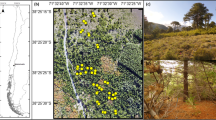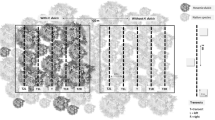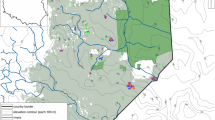Abstract
The sandy-savanna Mussununga is a little-known ecosystem that is already presenting signs of degradation due to effects of invasive species, anthropogenic disturbances, and land-use change. We investigated the effect of biological invasion by Acacia mangium and A. auriculiformis, disturbance promoted by fire and Eucalyptus management, as well as land-use change around Mussununga patches in this neglected ecosystem. Acacia occurrence is negatively related to abundance, basal area, and height of native woody species, and positively correlated with the proportion of dead woody plants. There is a trend of change in vegetation type from open savanna to woodland Mussununga promoted by Acacia. Mussununga patches disturbed by the planting of Eucalyptus species in the past have greater richness in the woody layer (large shrubs and trees), but lower abundance of species in the ground layer (small shrubs and herbs). The land-use change from forest to Eucalyptus plantation was associated with an increase of richness and abundance in the ground layer. Acacia tends to dominate the woody community in Mussununga by invading treeless patches, presenting a correlation with death of woody plants. Subsequently, Acacia promotes several changes that culminate in a height increment and change of the vegetation type. Different from Acacia, disturbance and land-use change associated with Eucalyptus, the main economic activity in the study area, affected both woody and ground layers. The conservation of Mussununga should include actions to preclude disturbance and land-use change, as well as monitoring and control of biological invasion.




Similar content being viewed by others
References
Aguiar A Jr, Barbosa RI, Barbosa JBF, Mourao M Jr (2014) Invasion of Acacia mangium in Amazonian savannas following planting for forestry. Plant Ecol Divers 7:359–369. https://doi.org/10.1080/17550874.2013.771714
Alvares CA, Stape JL, Sentelhas PC et al (2014) Köppen’s climate classification map for Brazil. Meteorol Zeitschrift 22:711–728. https://doi.org/10.1127/0941-2948/2013/0507
Bates D, Maechler M, Bolker B, Walker S (2015) Fitting linear mixed-effects models using lme4. J Stat Softw 67:1–48. https://doi.org/10.18637/jss.v067.i01
Braun-Blanquet J (1979) Fitosociología: bases para el estudio de las comunidades vegetales. H. Blume, Madrid
Brazilian Flora 2020 (2017) Jardim Botânico do Rio de Janeiro, Rio de Janeiro, Brazil. Available at: http://floradobrasil.jbrj.gov.br/. Accessed June 29 2017
Costello DA, Lunt ID, Williams JE (2000) Effects of invasion by the indigenous shrub Acacia sophorae on plant composition of coastal grasslands in south-eastern Australia. Biol Conserv 96:113–121. https://doi.org/10.1016/S0006-3207(00)00058-6
Delnatte C, Meyer J-Y (2012) Plant introduction, naturalization, and invasion in French Guiana (South America). Biol Invasions 14:915–927. https://doi.org/10.1007/s10530-011-0129-1
Didham RK, Tylianakis JM, Hutchison MA et al (2005) Are invasive species the drivers of ecological change? Trends Ecol Evol 20:470–474. https://doi.org/10.1016/j.tree.2005.07.006
Dillis C, Marshall AJ, Rejmánek M (2017) Change in disturbance regime facilitates invasion by Bellucia pentamera Naudin (Melastomataceae) at Gunung Palung National Park, Indonesia. Biol Invasions 19:1329–1337. https://doi.org/10.1007/s10530-016-1345-5
Donaldson JE, Hui C, Richardson DM et al (2014a) Invasion trajectory of alien trees: the role of introduction pathway and planting history. Glob Change Biol 20:1527–1537. https://doi.org/10.1111/gcb.12486
Donaldson JE, Richardson DM, Wilson JRU (2014b) The seed ecology of an ornamental wattle in South Africa: why has Acacia elata not invaded a greater area? S Afr J Bot 94:40–45. https://doi.org/10.1016/j.sajb.2014.05.004
Eisenlohr PV, Oliveira-Filho AT, Prado J (2015) The Brazilian Atlantic Forest: new findings, challenges and prospects in a shrinking hotspot. Biodivers Conserv 24:2129–2133. https://doi.org/10.1007/s10531-015-0995-4
Ferreira VBR, Nascimento MT, de Menezes LFT (2014) Floristic and phytogeographic pattern of native field in southeastern Brazil. Acta Bot Bras 28:465–475. https://doi.org/10.1590/0102-33062014abb3556
Fischer FM, Oliveira JM, Dresseno ALP, Pillar VD (2014) The role of invasive pine on changes of plant composition and functional traits in a coastal dune ecosystem. Nat Conserv 12:19–23. https://doi.org/10.4322/natcon.2014.004
Fox J, Monette G (1992) Generalized collinearity diagnostics. J Am Stat Assoc 87:178–183
Fox J, Weisberg S (2011) An R companion to applied regression, 2nd edn. Sage, Thousands Oaks
Fridley JD, Stachowicz JJ, Naeem S et al (2007) The invasion paradox: reconciling pattern and process in species invasions. Ecology 88:3–17. https://doi.org/10.1890/0012-9658(2007)88%5b3:Tiprpa%5d2.0.Co;2
Gaertner M, Den Breeyen A, Hui C et al (2009) Impacts of alien plant invasions on species richness in Mediterranean-type ecosystems: a meta-analysis. Prog Phys Geogr 33:319–338. https://doi.org/10.1177/0309133309341607
Gaertner M, Biggs R, Te Beest M et al (2014) Invasive plants as drivers of regime shifts: identifying high-priority invaders that alter feedback relationships. Divers Distrib 20:733–744. https://doi.org/10.1111/ddi.12182
Gastauer M, Saporetti-Junior AW, Valladares F, Meira-Neto JAA (2017) Phylogenetic community structure reveals differences in plant community assembly of an oligotrophic white-sand ecosystem from the Brazilian Atlantic Forest. Acta Bot Bras 31:531–538. https://doi.org/10.1590/0102-33062016abb0442
Griffin AR, Midgley SJ, Bush D et al (2011) Global uses of Australian acacias - recent trends and future prospects. Divers Distrib 17:837–847. https://doi.org/10.1111/j.1472-4642.2011.00814.x
Große-Stoltenberg A, Hellmann C, Thiele J et al (2018) Invasive acacias differ from native dune species in the hyperspectral/biochemical trait space. J Veg Sci. https://doi.org/10.1111/jvs.12608
Gurevitch J, Padilla DK (2004) Are invasive species a major cause of extinctions? Trends Ecol Evol 19:470–474. https://doi.org/10.1016/j.tree.2004.07.005
Hellmann C, Sutter R, Rascher KG et al (2011) Impact of an exotic N2-fixing Acacia on composition and N status of a native Mediterranean community. Acta Oecol 37:43–50. https://doi.org/10.1016/j.actao.2010.11.005
Hoffmann WA (1996) The effects of fire and cover on seedling establishment in a Neotropical Savanna.pdf. J Ecol 84:383–393
Holst KK (2014) gof: Model-diagnostics based on cumulative residuals. R package version 0.9.1
I3 N Brazil – National Database of Invasive Alien Species Brazil (2017) Instituto Hórus de Desenvolvimento e Conservação Ambiental, Florianópolis, Brazil. Available at: http://i3n.institutohorus.org.br/www. Accessed June 30 2017
IBGE – Instituto Brasileiro de Geografia e Estatística (2004) Mapa da Vegetação do Brasil. Rio de Janeiro, Brasil. Available at: ftp://ftp.ibge.gov.br/Cartas_e_Mapas/Mapas_Murais/. Accessed June 29 2017
Kennedy TA, Naeem S, Howe KM et al (2002) Biodiversity as a barrier to ecological invasion. Nature 417:636–638. https://doi.org/10.1038/nature00776
Koutika L-S, Richardson DM (2019) Acacia mangium Willd: benefits and threats associated with its increasing use around the world. For Ecosyst 6. https://doi.org/10.1186/s40663-019-0159-1
Lannes LS, Bustamente MMC, Edwards PJ, Venterink HO (2016) Native and alien herbaceous plants in the Brazilian Cerrado are (co-)limited by different nutrients. Plant Soil 400:231–243. https://doi.org/10.1007/s11104-015-2725-9
Le Maitre DC, Gaertner M, Marchante E et al (2011) Impacts of invasive Australian acacias: implications for management and restoration. Divers Distrib 17:1015–1029. https://doi.org/10.1111/j.1472-4642.2011.00816.x
Lehmann JR, Prinz T, Ziller SR et al (2017) Open-source processing and analysis of aerial imagery acquired with a low-cost unmanned aerial system to support invasive plant management. Environ Sci. https://doi.org/10.3389/fenvs.2017.00044
Marchante H, Marchante E, Freitas H (2003) Invasion of the Portuguese dune ecosystems by the exotic species Acacia longifolia (Andrews) Willd.: effects at the community level. In: Child LE, Brock JH, Brundu G et al (eds) Plant invasions: ecological threats and management solutions. Backhuys, Leiden, pp 75–85
Marchante E, Kjøller A, Struwe S, Freitas H (2008) Short- and long-term impacts of Acacia longifolia invasion on the below ground processes of a Mediterranean coastal dune ecosystem. Appl Soil Ecol 40:210–217. https://doi.org/10.1016/j.apsoil.2008.04.004
Marchante E, Kjøller A, Struwe S, Freitas H (2009) Soil recovery after removal of the N2-fixing invasive Acacia longifolia: consequences for ecosystem restoration. Biol Invasions 11:813–823. https://doi.org/10.1007/s10530-008-9295-1
Meira-Neto JAA, de Souza AL, de Lana JM, Valente GE (2005) Composição florística, espectro biológico e fitofisionomia da vegetação de muçununga nos municípios de Caravelas e Mucuri, Bahia. Rev Árvore 29:139–150. https://doi.org/10.1590/S0100-67622005000100015
Meira-Neto JAA, Silva MCNA, Tolentino GS et al (2017) Early Acacia invasion in a sandy ecosystem enables shading mediated by soil, leaf nitrogen, and facilitation. Biol Invasions. https://doi.org/10.1007/s10530-017-1647-2
Miller AD, Roxburgh SH, Shea K (2011) How frequency and intensity shape diversity–disturbance relationships. Proc Natl Acad Sci 108:5643–5648. https://doi.org/10.1073/pnas.1018594108
Moreira AG (2000) Effects of fire protection on savanna structure in Central Brazil. J Biogeogr 27:1021–1029. https://doi.org/10.1046/j.1365-2699.2000.00422.x
Murphy DJ (2008) A review of the classification of the Acacia (Leguminosae, Mimosoideae). Muelleria 26:10–26
National Research Council (1983) Mangium and other fast-growing Acacias for the humid tropics. National Academy Press, Washington
Oksanen J, Blanchet FG, Friendly M, et al (2016) vegan: Community ecology package. R package version 2.4-0. https://CRAN.R-project.org/package=vegan
Oliveira-Filho AT, Ratter JA (2002) Vegetation physiognomies and woody flora of the Cerrado biome. In: Oliveira PS, Marquis RJ (eds) The cerrados of Brazil: ecology and natural history of a neotropical savanna. Columbia University Press, New York, pp 91–120
Peterson BG, Carl P (2014) Performance analytics: econometric tools for performance and risk analysis. R package version 1.4.3541. https://CRAN.R-project.org/package=PerformanceAnalytics
Pollnac F, Seipel T, Repath C, Rew LJ (2012) Plant invasion at landscape and local scales along roadways in the mountainous region of the Greater Yellowstone Ecosystem. Biol Invasions 14:1753–1763. https://doi.org/10.1007/s10530-012-0188-y
R Development Core Team (2016) R: A language and environment for statistical computing. R Foundation for Statistical Computing, Vienna, Austria. ISBN 3-900051-07-0, Available at: http://www.R-project.org/. Accessed June 29 2017
Rascher KG, Große-Stoltenberg A, Maguas C et al (2011) Acacia longifolia invasion impacts vegetation structure and regeneration dynamics in open dunes and pine forests. Biol Invasions 13:1099–1113. https://doi.org/10.1007/s10530-011-9949-2
Richardson DM, Rejmánek M (2011) Trees and shrubs as invasive alien species: a global review. Divers Distrib 17:788–809. https://doi.org/10.1111/j.1472-4642.2011.00782.x
Saporetti-Junior AW, Schaefer CEGR, de Souza AL et al (2012) Influence of soil physical properties on plants of the Mussununga ecosystem, Brazil. Folia Geobot 47:29–39. https://doi.org/10.1007/s12224-011-9106-9
Thiele J, Schuckert U, Otte A (2008) Cultural landscapes of Germany are patch-corridor-matrix mosaics for an invasive megaforb. Landsc Ecol 23:453–465. https://doi.org/10.1007/s10980-008-9202-2
Thiele J, Buchholz S, Schirmel J (2018) Using resistance distance from circuit theory to model dispersal through habitat corridors. J Plant Ecol 11:385–393. https://doi.org/10.1093/jpe/rtx004
Venables WN, Ripley BD (2002) Modern applied statistics with S, 4th edn. Springer, New York
Vitousek PM, Mooney HA, Lubchenco J, Melillo JM (1997) Human domination of earth’s ecosystems. Science 277:494–499. https://doi.org/10.1126/science.277.5325.494
Yang L, Liu N, Ren H, Wang J (2009) Facilitation by two exotic Acacia: Acacia auriculiformis and Acacia mangium as nurse plants in South China. For Ecol Manag 257:1786–1793. https://doi.org/10.1016/j.foreco.2009.01.033
Acknowledgements
We thank Coordination for the Improvement of Higher Education Personnel (CAPES) and the European Union’s Seventh Framework Programme FP7-PEOPLE-2010-IRSES (“INSPECTED.NET” Project – Proposal No. 269206) for the fellowships granted to GH during his PhD; CAPES and the Fundação de Amparo à Pesquisa do Estado de Minas Gerais (FAPEMIG) for the postdoctoral fellowship to GH; Conselho Nacional de Desenvolvimento Científico e Tecnológico (CNPq) for the productivity fellowship to JAAMN (No. 307591/2016-6); Geovane S. Siqueira, Eric K.O. Hattori, Pedro L. Viana and Mariana O. Bünger for plant identification; Lívia C. de Siqueira, Hugo G. Cândido, Nathália V.H. Safar, Eric K.O. Hattori, Leonardo R.M. Palmeira, Alex J. P. Coelho, Gabriel R. Silva and Rafael D. Marques for the assistance provided during field work; Luiz F.S. Magnago, Fabio A.R. Mato, and Maria Carolina N.A. da Silva for the helpful discussions during the development of this study; the company Vale S.A. for granting us permission to perform the study at the Vale Natural Reserve; and Dave Richardson and two anonymous reviewers for the very helpful improvements that were suggested.
Author information
Authors and Affiliations
Corresponding authors
Additional information
Publisher's Note
Springer Nature remains neutral with regard to jurisdictional claims in published maps and institutional affiliations.
Electronic supplementary material
Below is the link to the electronic supplementary material.
Rights and permissions
About this article
Cite this article
Heringer, G., Thiele, J., Meira-Neto, J.A.A. et al. Biological invasion threatens the sandy-savanna Mussununga ecosystem in the Brazilian Atlantic Forest. Biol Invasions 21, 2045–2057 (2019). https://doi.org/10.1007/s10530-019-01955-5
Received:
Accepted:
Published:
Issue Date:
DOI: https://doi.org/10.1007/s10530-019-01955-5




